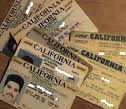There’s a lot of semantic debate these days over what to name foreign nationals who violate U.S. immigration policies and national laws – whether you call them illegal immigrants, illegal aliens or undocumented workers, it comes down to the same thing at the end of the day for every business: hire them, and you’ll pay big fines if detected. Though the majority of U.S. companies do not intend to violate immigration laws; in fact, more compliance violations occur from nonexistent or simple lazy I-9 verification than intentionally shady hiring practices. Breaking the law is easily accomplished if you’re not properly prepared; the bottom line is this –
“If you are not actively planning to examine and verify employee documentation properly, you are planning to break the law”.

I-9 Compliance requires all businesses to be able to demonstrate that they’ve made an honest effort to verify that an applicant who completes an I-9 form for employment is who he or she claims to be – a U.S. citizen or a worker authorized to work in the United States.
Unfortunately, it’s not enough to simply ask an applicant to complete the required I-9 form and provide a photo ID in the Age of Technology. Fabricating false identification is as easy as a few mouse clicks and familiarity with a digital camera and high quality printer. The fight is particularly fierce in California and Texas; these border states are experiencing an onslaught fake ID rings, whose sophisticated document-making equipment can produce high quality fake IDs, passports and social security cards at a charge of about $100 per item to their customers. This is considered a small price to pay for those seeking a means of acquiring the pay and benefits of an American job.
Businesses Ultimately Pay the Price
As a result of the ubiquity of these activities, unprepared businesses are the ones that will pay some of the biggest prices. Penalties range from $100 to $1,000 for each incorrect or missing I-9 and there are steeper fines for employing undocumented workers.
Fortunately, with today’s leading ID document verification tools, you don’t have to be an expert to make a good faith effort, and in fact go beyond good faith efforts to securely verify the legitimacy of a potential employee’s identity. In addition, here are a few tips to make sure you are doing all you can to avoid hiring unauthorized workers and achieve I-9 Compliance:
- Implement a procedure – Implement I-9 form compliance management routines into your daily new hire orientation paperwork so you never forget to obtain this important documentation. Never to be considered a mere afterthought, having an I-9 form completed a month into the job, when the employee has had time to come up with falsified documents, is not a preventative strategy.
- Be a witness - Make sure you fill out the Employer section of the I-9 form yourself. Non-compliant employers give the I-9 form to the employee to complete along with other new hire paperwork, and forget to look at it later.
- Don’t depend on your own eyes – writing down the passport, driver’s license or social security info on the I-9 form and glancing at the photo won’t do the job; and, if you’re caught with an unauthorized worker, you will have a hard time proving that you properly examined the documents you were given. Invest in the latest equipment to verify documents and record their images in a secure database.
- Invest in your own security – You can enhance your hiring process with internal identification solutions and ID lookup authenticators. Not only can you disable the fake ID rings’ technological advances with superior capability, you will be empowered to prove you did everything possible to verify identity without worry. Remember, if the documents presented to you reasonably appear to be genuine, you must accept them. If a document does not reasonably appear on its face to be genuine, you must not accept it. Even the seasoned veteran can be nervous trying to decide what’s “reasonable” given all the various documents and IDs acceptable for I-9 compliance.
Now, you can have peace of mind and take yourself out of the equation!
- Save photocopied documents safely – Though the INS Handbook for Employers suggests keeping photocopies of I-9 photos and I-9 forms together in an employee’s file, this can be problematic when it comes to other rules, like anti-discrimination. Employers have been sued and defeated in court by employees who believe their photos, present in the employee file, impacted reviews, raises, etc. To avoid such complications, store ID’s separately from employment records. It should be noted that for such matters, it is advised that you seek expert consultation.
- Know the rules and implement a solution – I-9 has various rules that range from basic rules for validating documentation and keeping your records in order to how you should manage exceptions. It is important to know all of the rules when you realize that you must meet all of the requirements while being aware of anti-discrimination rules.
Finally, President Obama gave a highly publicized speech yesterday on his efforts to strengthen borders and create a “pathway to legal status” for the estimated 11 million illegal immigrants. According to some reports, this speech unleashed protests and reignited the divisive battle over immigration reform nationally. For those of us in the profession of fraud prevention, it is interesting to read two reviews from the political pundits on the liberal and conservative sides to see how they can arrive at completely different viewpoints.
For businesses who thrive on profitability though, there should be an overwhelming consensus.


